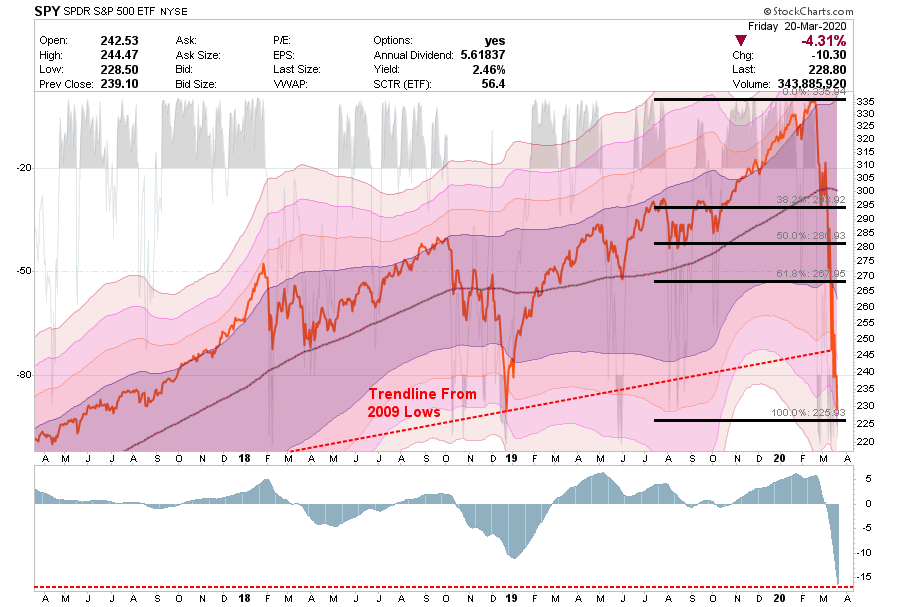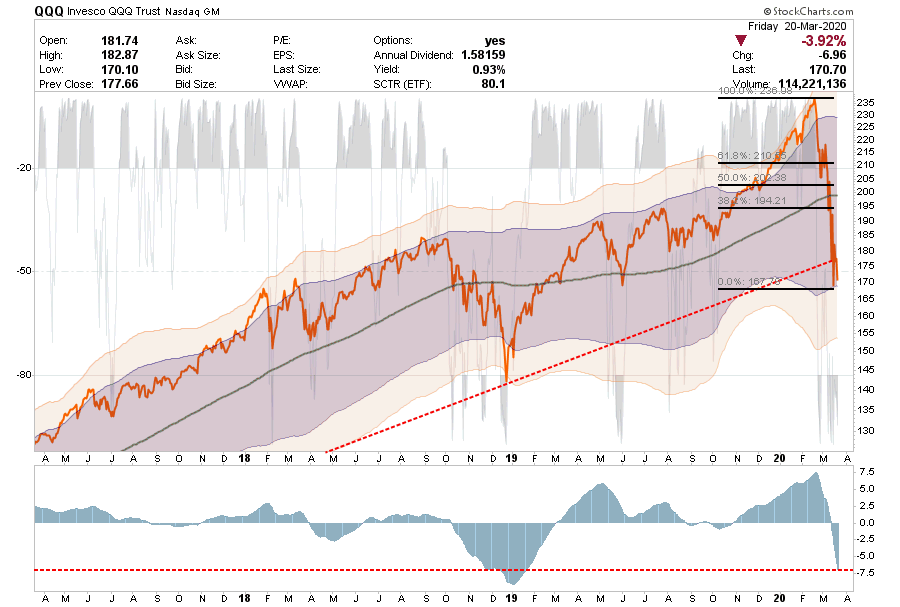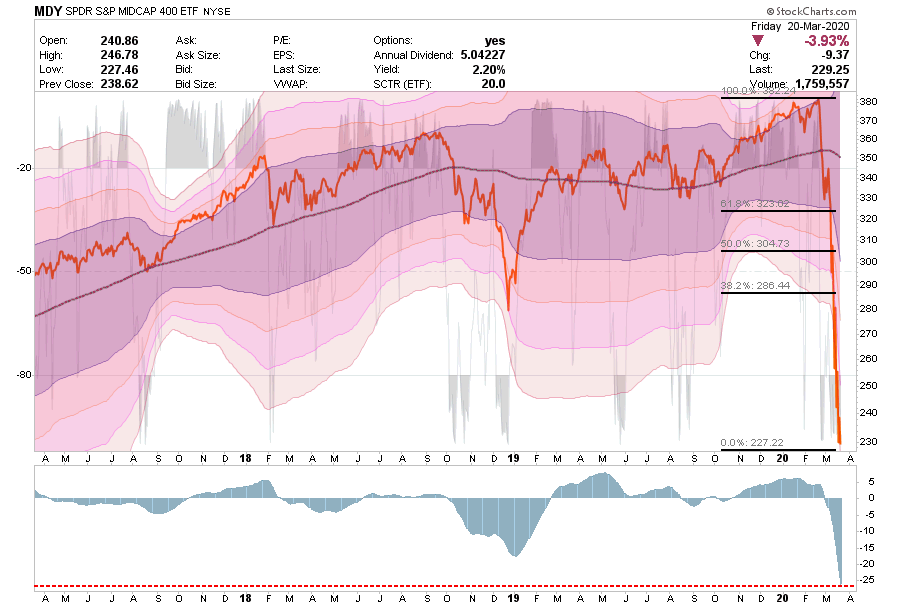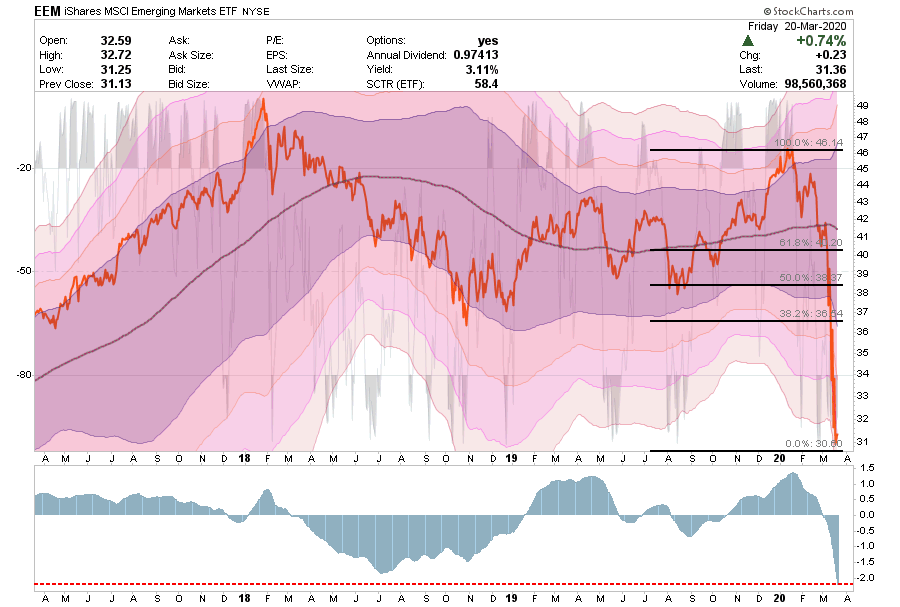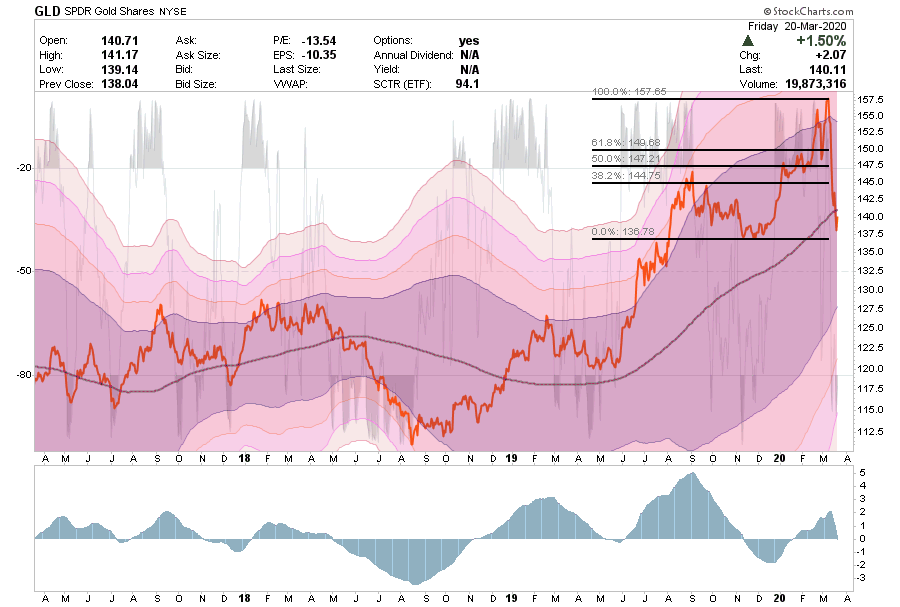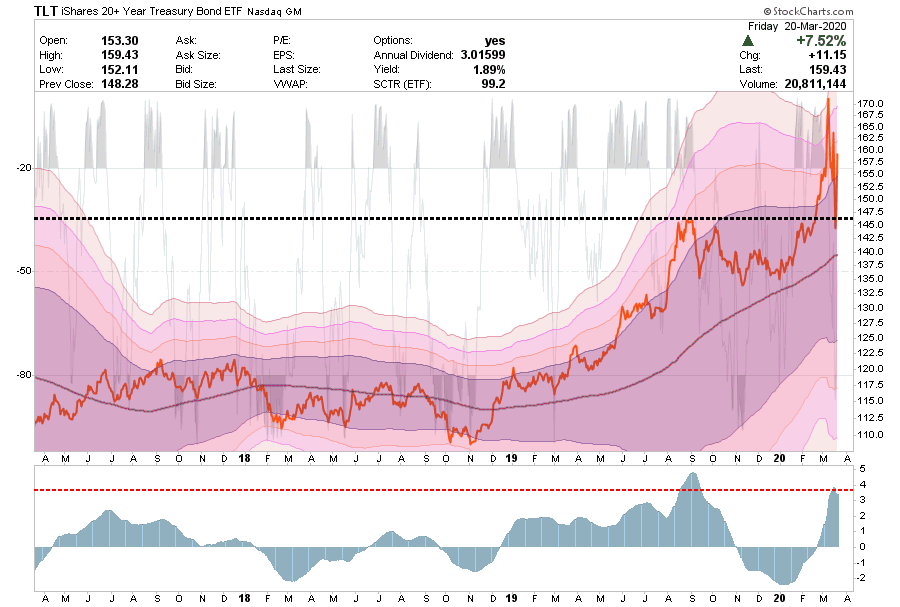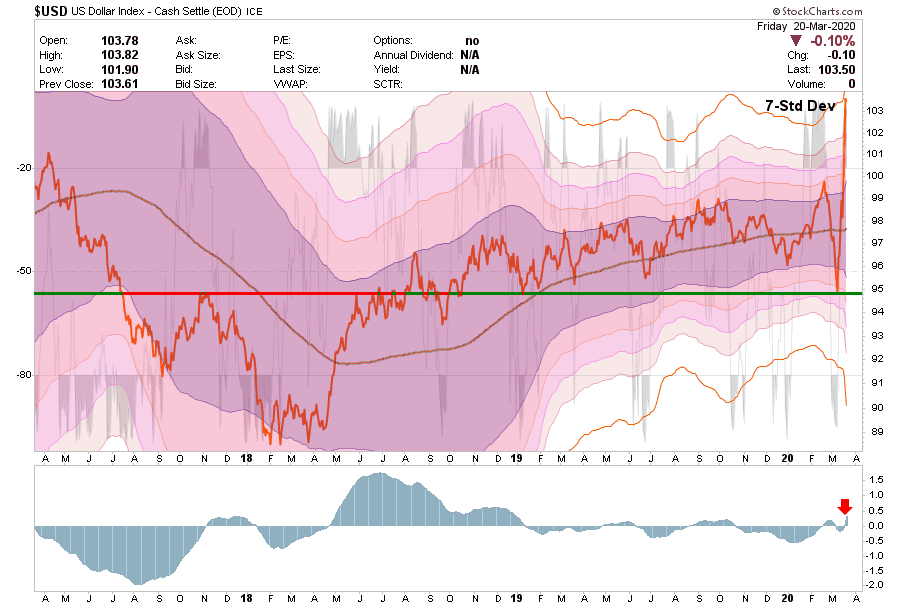HOW TO READ THE CHARTS
There are three primary components to each chart:
- The price chart is in orange
- The Over Bought/Over Sold indicator is in gray
- The Buy / Sell indicator is in blue.
When the gray indicator is at the TOP of the chart, there is typically more risk and less reward available at the current time. In other words, the best time to BUY is when the short-term condition is over-sold. Likewise when the buy/sell indicator is above the ZERO line investments have a tendency of working better than when below the zero line.
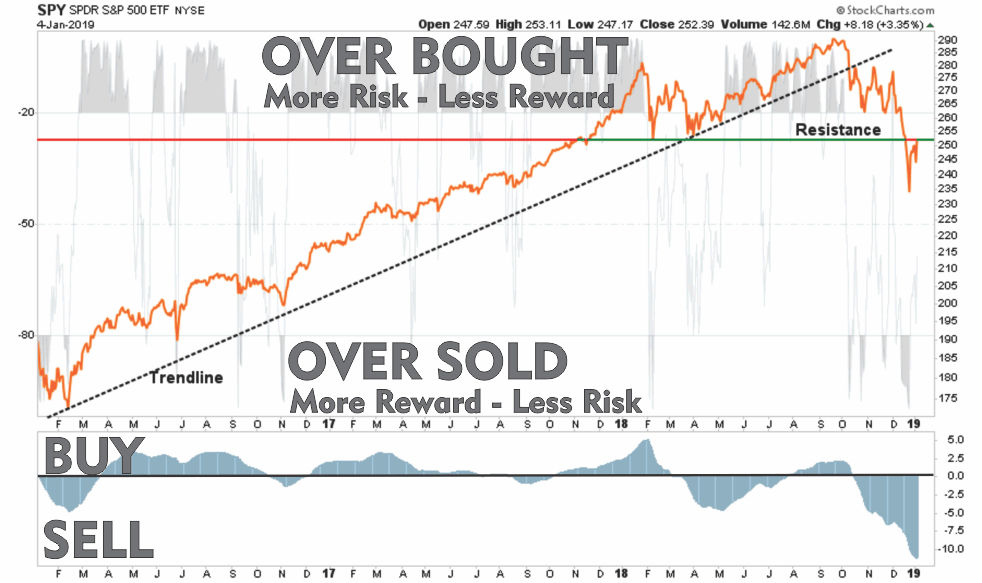
With this basic tutorial let’s review the major markets.
S&P 500 Index
- Last week: “With the market now 3-standard deviations oversold, a bounce is likely next week as it is expected the Fed will cut rates and restart a substantial QE program. A retracement to the 31.8%, 50%, 62.8% levels are possible and each level should be used to reduce equity risk and hedge.”
- Well, no bounce this week, and markets are even more extended and deviated the previously.
- Again, we suspect a bounce is likely from such extreme moves, but a retest of lows likely before this over.
- Short-Term Positioning: Bearish – Market Risk Is High
- Last Week: Hold position
- This Week: No position
- Stop-loss set at $250
- Long-Term Positioning: Bearish
Dow Jones Industrial Average
- The same situation exists with DIA.
- DIA is on a very deep “Sell signal” so rallies will most likely fail in the weeks ahead. All stops have been triggered on trading positions.
- A bounce is still likely, stops reset at recent lows.
- Short-Term Positioning: Bearish – Market Risk Is High
- Last Week: Hold current positions
- This Week: No positions.
- Stop-loss set at $190
- Long-Term Positioning: Bearish
Nasdaq Composite
- QQQ tested and violated its bullish trend line, is now on a deep “sell signal.” This suggests that rallies will likely fail for the time being.
- The index is very oversold, so a reflexive rally back to $190-195 is possible. which coincides with the 200-dma,
- Trading positions only with stops at recent lows.
- Short-Term Positioning: Bearish – Market Risk Is High
- Last Week: Hold position
- This Week: No positions
- Stop-loss set at $170
- Long-Term Positioning: Bearish due to valuations
S&P 600 Index (Small-Cap)
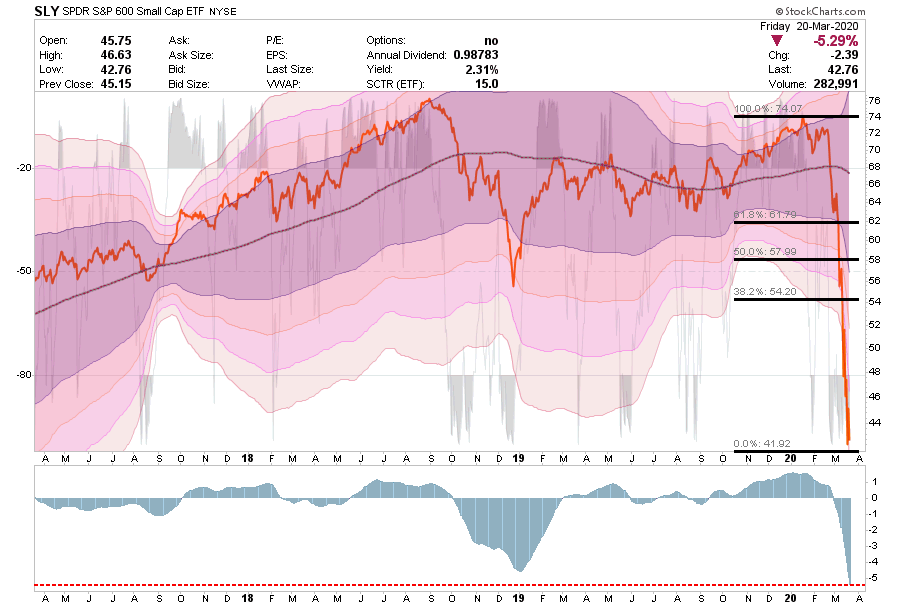
- As noted in our portfolio commentary, we sold our small-cap positions 5-weeks ago.
- Small-caps are extremely oversold, and on a very deep “sell signal.”
- This particular group of stocks are the most susceptible to an economic slowdown from the virus. Use any reflexive rally to step-aside for the time being.
- You can deploy a trading position in small-caps for a bounce, but they are underperforming large cap, so I am not sure its worth the risk.
- Short-Term Positioning: Bearish – Market Risk Is High
- Last Week: No positions
- This Week: No positions.
- Stop loss adjusted to $42 on trading positions.
- Long-Term Positioning: Bearish
S&P 400 Index (Mid-Cap)
- As with Small-cap, we have no holdings.
- MDY is oversold, and is on a very deep a “sell signal.”
- MDY has broken all critical supports, and like SLY, there is no reason to “buy” the sector currently. However, MDY is oversold enough for a counter-trend bounce to sell into. Trading positions only.
- Short-Term Positioning: Bearish – Market Risk Is High
- Last Week: No holding
- This Week: No holding
- Long-Term Positioning: Bearish
Emerging Markets
- Last week: “EEM has completed a “head and shoulders” topping pattern and violated support at the 61.8% retracement level. EEM will eventually test previous lows particularly with a sell signal now registered.”
- EEM is very now extremely oversold and on a deep sell-signal.
- Use counter-trend rallies to sell into. Trading positions only.
- Short-Term Positioning: Bearish – Market Risk Is High
- Last Week: No position
- This Week: No position.
- Stop-loss set at $30 for trading positions.
- Long-Term Positioning: Bearish
International Markets
- Like EEM, EFA was also sold previously. as we return our focus back to large cap value.
- EFA is very sold and on a deep sell signal. A reflexive rally is likely back to $58 to 63 which doesn’t even get you back to the 200-dma. Use those levels to sell into.
- Short-Term Positioning: Bearish – Market Risk Is High
- Last Week: No position.
- This Week: No position.
- Stop-loss set at $46 for trading positions.
- Long-Term Positioning: Bearish
West Texas Intermediate Crude (Oil)
- As noted last week: “We just didn’t realize how bad it would get until Saudi Arabia decided to launch a price war, thankfully, we had recommended selling all energy holdings on the Friday before that announcement.”
- We still like the sector from a “value” perspective and expect that we will wind up making a lot of money here. We clearly aren’t at lows yet, so be patient.
- Short-Term Positioning: Bearish
- Last Week: No positions
- This Week: No positions.
- Stops Triggered for any direct crude oil positions.
- Long-Term Positioning: Bearish
Gold
- Last week we noted: “Gold had been holding up well as a hedge until this past week where two hedge funds (we suspect Citadel and Millennium) blew up creating margin liquidation across all asset classes included gold, bonds, and even bitcoin.”
- It seems that liquidation event may be passing. If Gold can climb back above the 200-dma we will look to add back our holdings.
- We also added a small position to GDX this past week, as the previous liquidation left a lot of value in the sector.
- Short-Term Positioning: Bullish
- Last week: Hold positions.
- This week: Look to add above $140.
- Stop-loss set at $137.50.
- Long-Term Positioning: Bullish
Bonds (Inverse Of Interest Rates)
- As noted last week: “We previously sold our small position in TLT, and this past week reduced our IEF position by 50% and increased BIL accordingly to shorten duration. The rest of our bond holdings have done the work of supporting the portfolio.”
- The margin liquidation event is now bringing bonds back to a “buyable” range and bonds did hold support at the previous market highs.
- We remain very cautious on our bond exposure currently, and will look to add to that exposure once the credit markets calm down a bit.
- Short-Term Positioning: Neutral
- Last Week: Hold positions
- This Week: Sold bond mutual funds, added position of STIP.
- Stop-loss is moved up to $147.50
- Long-Term Positioning: Bullish
U.S. Dollar
- Three weeks ago we stated: “This past week, the dollar surged through that resistance and is now extremely overbought short-term. Looking for a reflexive rally in stocks next week that pulls the dollar back towards the breakout level of last week.
- The credit crisis, and rush to cash, has sent the dollar surging to 7-deviations above the mean. As the credit markets calm down we should see relationship between asset classes return to normal.
- The dollar has reversed its sell signal, which suggests dollar strength may be with us for a while longer.
Lance Roberts is a Chief Portfolio Strategist/Economist for RIA Advisors. He is also the host of “The Lance Roberts Podcast” and Chief Editor of the “Real Investment Advice” website and author of “Real Investment Daily” blog and “Real Investment Report“. Follow Lance on Facebook, Twitter, Linked-In and YouTube
Customer Relationship Summary (Form CRS)
Also Read








